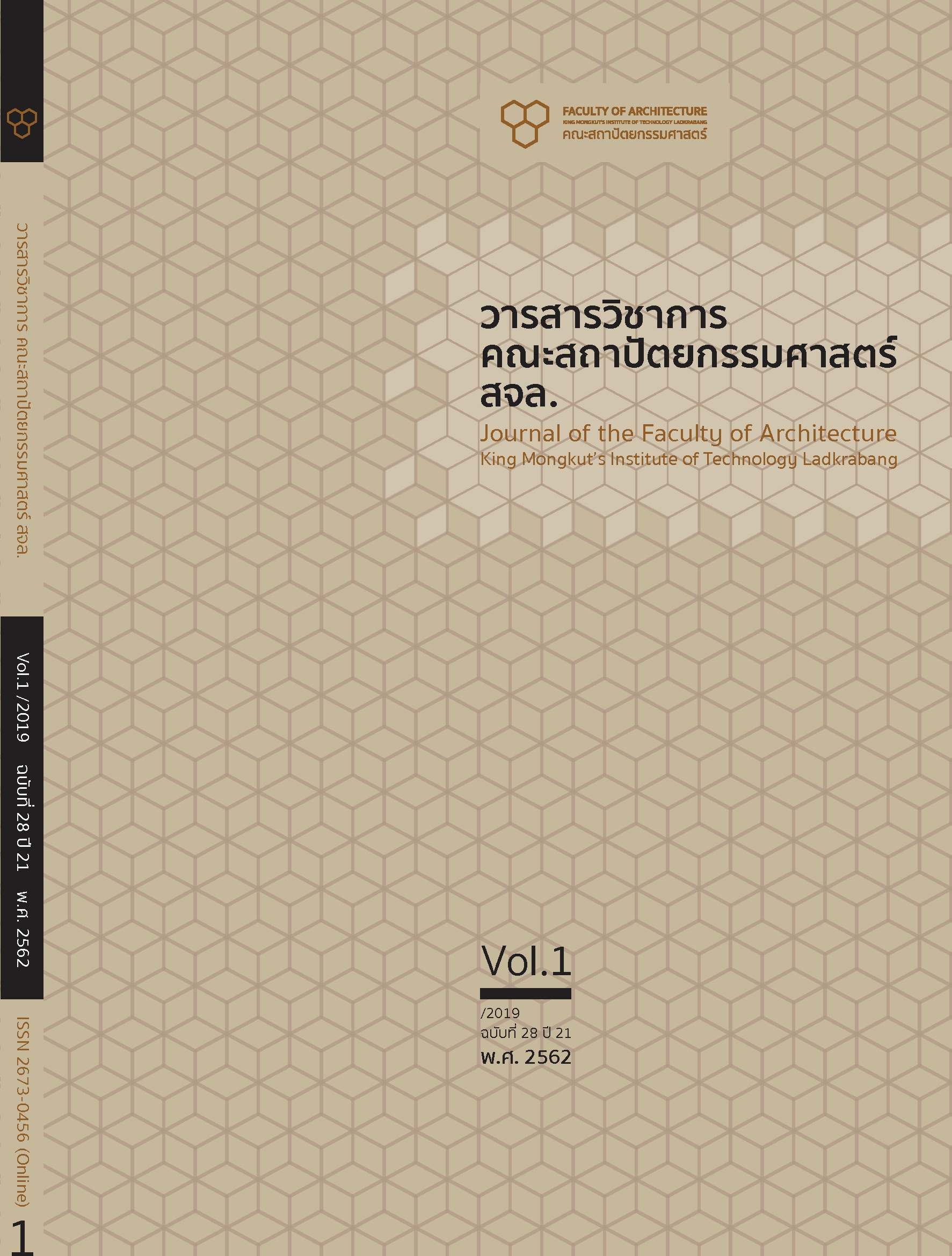Comparative Analysis of the Course Subject Matters to the Expected Learning Outcomes of Bachelor of Fine and Applied Arts Program in 3D-Based Communication Design (Revised Year 2011)
Main Article Content
Abstract
บทคัดย่อ
การวิจัยครั้งนี้มีวัตถุประสงค์ เพื่อวิเคราะห์รายวิชาในหมวดวิชาเฉพาะกลุ่มวิชาพื้นฐานวิชาชีพและกลุ่มวิชาชีพบังคับในหลักสูตรศิลปกรรมศาสตรบัณฑิต สาขาการออกแบบสนเทศสามมิติ (หลักสูตรปรับปรุง พ.ศ. 2554) เปรียบเทียบกับผลการเรียนรู้ที่คาดหวังตามจุดมุ่งหมายของหลักสูตร ในด้านความรู้ ทักษะด้านความคิด และทักษะทางด้านศิลปะและ การออกแบบเก็บข้อมูลอย่างเป็นระบบจากประชากรโดยใช้ การสนทนากลุ่ม จากนั้นวิเคราะห์เนื้อหาที่ได้ จากการสนทนากลุ่ม สรุปผลและจัดทำข้อมูลที่ได้ในรูปแบบแผนผังใยแมงมุม
ผลการวิจัยพบว่าลักษณะการเรียนการสอนของทุกรายวิชาครอบคลุมผลการเรียนรู้ที่คาดหวังตามจุดมุ่งหมายของหลักสูตร แต่ไม่สามารถแสดงสัดส่วนที่สมดุลสอดคล้องกันอย่างเหมาะสมของผลการเรียนรู้ที่คาดหวัง ปัจจัยสำคัญส่วนหนึ่ง ได้แก่ การวางโครงสร้างหลักสูตร ซึ่งยังขาดรายวิชาที่เน้นการฝึกฝนทักษะด้านการใช้ความคิดโดยเฉพาะ ซึ่งเป็นทักษะในส่วนที่หลักสูตรต้องการเน้นย้ำเพื่อสร้างเอกลักษณ์ทางวิชาการ ปัจจัยอีกส่วนหนึ่งได้ แก่การวางแผนการเรียนการสอนในรายละเอียดของแต่ละรายวิชาที่คลาดเคลื่อนไปจากผลการเรียนรู้ที่คาดหวัง
คำสำคัญ: ผลการเรียนรู้ที่คาดหวัง การออกแบบสนเทศสามมิติ แผนผังใยแมงมุม จุดมุ่งหมายทางการศึกษา
Abstract
This study aims to evaluate teaching and learning subjects in the foundation and mandatory courses of Bachelor Degree of Fine and Applied Arts Program in 3D-Based Communication Design (Revised year 2011) comparing to the 3 specific aspects of the program learning outcomes including 1) knowledge and 2) thinking skills, and 3) art and design skills. Research data was collected by focus group interview. Content analysis combining with spider diagram was used to analyze research data and visually present the results.
The results of the study showed that the characteristics of teaching and learning of all subjects covered the expected learning outcomes according to the course objectives, but it did not show any balance proportion of the 3 specific aspects of the program learning outcomes that is appropriately consistent. A significant factor contributing to this conclusion was the program structure in which the subject courses particularly focusing on thinking skills are deficient. Another considerable factor was the action plan of teaching and learning details in each subject course, which some were not completely aligned with the course learning outcomes.
Keywords: Expected Learning Outcome, 3D-Based Communication Design, Spider Diagram, Taxonomy of Educations
Article Details
This work is licensed under a Creative Commons Attribution-NonCommercial-ShareAlike 4.0 International License.
Copyright Transfer Statement
The copyright of this article is transferred to Journal of The Faculty of Architecture King Mongkut's Institute of Technology Ladkrabang with effect if and when the article is accepted for publication. The copyright transfer covers the exclusive right to reproduce and distribute the article, including reprints, translations, photographic reproductions, electronic form (offline, online) or any other reproductions of similar nature.
The author warrants that this contribution is original and that he/she has full power to make this grant. The author signs for and accepts responsibility for releasing this material on behalf of any and all co-authors.
References
คณะสถาปัตยกรรมศาสตร์ สถาบันเทคโนโลยีพระจอมเกล้าเจ้าคุณทหารลาดกระบัง. (2555). หลักสูตรศิลปกรรมศาสตรบัณฑิต สาขาวิชาการออกแบบสนเทศสามมิติ (หลักสูตรปรับปรุง พ.ศ.2554). กรุงเทพมหานคร: คณะสถาปัตยกรรมศาสตร์ สถาบันเทคโนโลยีพระจอมเกล้าเจ้าคุณทหารลาดกระบัง.
ราชบัณฑิตยสถาน. (2551). พจนานุกรมศัพท์ศึกษาศาสตร์ อักษร A-L ฉบับราชบัณฑิตยสถาน. กรุงเทพฯ: อรุณการพิมพ์.
สานักงานคณะกรรมการอุดมศึกษา. (2552). กรอบมาตรฐานคุณวุฒิระดับอุดมศึกษา พ.ศ.๒๕๕๒. กรุงเทพฯ: สำนักงานคณะกรรมการอุดมศึกษา.
อุทุมพร ทองอุไทย. (2524). สารบบจำแนกจุดมุ่งหมายทางการศึกษา. กรุงเทพฯ: สมานมิตรการพิมพ์.
Anderson, L. W., & Krathwohl, D. R. (Eds.). (2001). A taxonomy for learning, teaching and assessing: A revision of Bloom's Taxonomy of educational objectives. New York: Longman.
Simpson, E. J. (1972). The Classification of Educational Objectives in the Psychomotor Domain. Washington, DC: Gryphon House.


